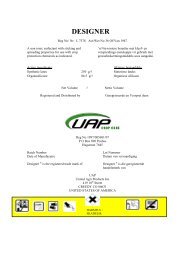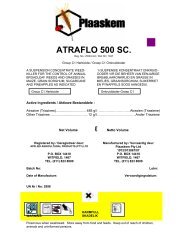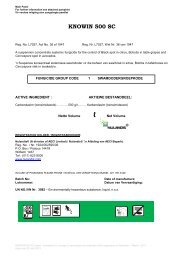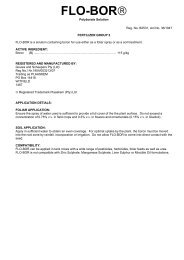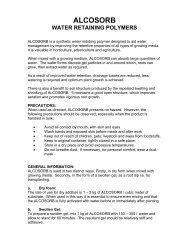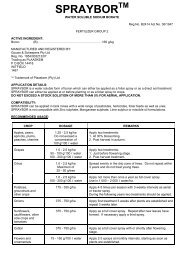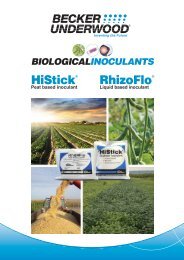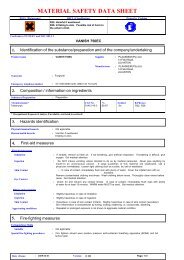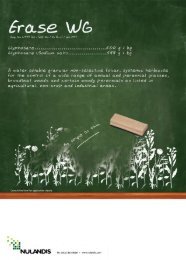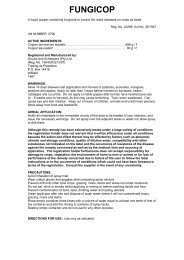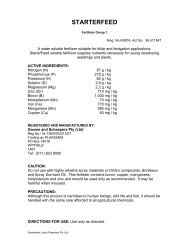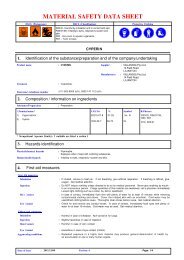You also want an ePaper? Increase the reach of your titles
YUMPU automatically turns print PDFs into web optimized ePapers that Google loves.
<strong>ERASE</strong> <strong>360</strong> S.L.<br />
Reg. No. L6206, Act / Wet 36 / 1947<br />
A NON-SELECTIVE SYSTEMIC POST-EMERGENCE HERBICIDE FOR THE CONTROL OF<br />
PERENNIAL AND ANNUAL WEEDS IN AGRICULTURE AND INDUSTRIAL AREAS.<br />
‘n NIE-SELEKTIEWE SISTEMIESE NA-OPKOMS ONKRUIDDODER VIR DIE BEHEER VAN<br />
EEN-EN MEERJARIGE ONKRUID IN LANDBOU EN INDUSTRIëLE GEBIEDE.<br />
GROUP G HERBICIDE / GROEP G ONKRUIDDODER<br />
Active Ingredient / Aktiewe Bestanddeel:<br />
Glyphosate<br />
Glifosaat<br />
………………………....................................................... <strong>360</strong> g / ℓ<br />
Glyphosate (Isopropylamine salt)<br />
………………………....................................................... 480 g / ℓ<br />
Glifosaat (Isopropielamien sout)<br />
Net Volume<br />
Netto Volume<br />
Registered by/Geregistreer deur: Manufactured by / Vervaardig deur:<br />
Kynoch Agrochemicals Pty Ltd Plaaskem Pty Ltd<br />
(Reg. No. 1972/13867/07) (Reg. No. 1972/13867/07)<br />
P.O. Box 14418 P.O. Box 14418<br />
Witfield 1467 Witfield 1467<br />
Tel: (011) 823 8000 Tel: (011) 823 8000<br />
Batch No: Date of Manufacture:<br />
Lotnr: Vervaardigingsdatum:<br />
Group/Groep III
WARNINGS<br />
Poisonous if swallowed. Avoid contact with skin and eyes since the product is an irritant.<br />
Can be corrosive to zinc and other metal equipment.<br />
Wash all spray equipment thoroughly after use and dispose of wash water where it will not<br />
contaminate crops, grazing, rivers, dams and boreholes.<br />
Do not mix, store or apply <strong>ERASE</strong> <strong>360</strong> S.L. solutions in galvanised or unlined steel (except<br />
stainless steel) containers or spray tanks.<br />
<strong>ERASE</strong> <strong>360</strong> S.L. may react with such containers to form a highly combustible and explosive<br />
gas mixture.<br />
TOX CLASS III:<br />
Re-entry interval: Do not enter treated area until spray deposit has dried unless wearing<br />
protective clothing<br />
Aerial application<br />
Notify all the inhabitants of the immediate vicinity of the area to be sprayed and issue the<br />
necessary warnings.<br />
Store away from feed, food, seed, fertilizer and other agricultural chemicals.<br />
Keep out reach of children, uninformed persons and animals.<br />
Although this remedy has been extensively tested under a large variety of conditions the<br />
registration holder does not warrant that it will be efficacious under all conditions because the<br />
action and effect thereof may be affected by factors such as abnormal climatic and storage<br />
conditions; quality of dilution water; compatibility with other substances not indicated on the<br />
label and the occurrence of resistance of weeds against the remedy concerned as well as by<br />
the method, time and accuracy of application. The registration holder furthermore does not<br />
accept responsibility for damage to crops, vegetation, the environment or harm to man or<br />
animal or for lack of performance of the remedy concerned due to failure of the user to follow<br />
the label instructions or to the occurrence of conditions, which could not have been foreseen in<br />
terms of the registration. Consult the registration holder in the event of any uncertainty.<br />
PRECAUTIONS<br />
Do not inhale fumes or spray mist.<br />
In case of accidental contact with skin or eyes, wash immediately with plenty of water and in<br />
the case of eyes, get medical attention if necessary.<br />
Prevent spray drift and/or contamination onto crops, grazing or any other area not under<br />
treatment as this will cause serious crop damage.<br />
<strong>ERASE</strong> <strong>360</strong> S.L. is actively absorbed through immature bark and may result in localised or<br />
translocated injury to plants.<br />
CONTACT WITH SPRAYDRIFT OR DIRECT CONTACT WITH LEAVES OR IMMATURE<br />
BARK AND FRUIT OF DESIRED PLANTS, MUST BE AVOIDED AT ALL COST.<br />
Invert the empty container over the spray or mixing tank and allow to drain for at least 30<br />
seconds after the flow has slowed down to a drip. Thereafter rinse the container three times<br />
with a volume of water equal to a minimum of 10% of that of the container. Add the rinses to<br />
the contents of the spray tank and destroy the container by perforation and flattening and do<br />
not use for any other purpose. Prevent contamination of food, feeds, drinking water and eating<br />
utensils.<br />
RESISTANCE WARNING:<br />
For resistance management, <strong>ERASE</strong> <strong>360</strong> S.L is a group G Herbicide. Any weed population<br />
may contain individuals naturally resistant to <strong>ERASE</strong> <strong>360</strong> S.L and other group G Herbicides.<br />
The resistant individuals can eventually dominate the weed population if these herbicides are<br />
used repeatedly. The resistant weeds may not be controlled by <strong>ERASE</strong> <strong>360</strong> S.L or any other<br />
group G Herbicides. The following species/weeds have been found to be resistant to<br />
glyphosate in some areas: Conyza spp (Fleabane), Lolium spp (Ryegrass), Plantago<br />
lanceolata (Narrow leaved ribwort)<br />
To delay herbicide resistance:<br />
• Avoid exclusive repeated use of herbicides from the same herbicide group code.<br />
Alternate or tank mix with registered products from different herbicide group codes.<br />
• Integrate other control methods (chemical, cultural, biological) into weed control<br />
programmes.<br />
For specific information on resistance management contact the registration holder of this<br />
product
DIRECTIONS FOR USE: Use only as directed<br />
<strong>ERASE</strong> <strong>360</strong> S.L. is a non-selective systemic herbicide, which is only active when applied postemergence<br />
to the foliage and immature (green) bark of plants.<br />
<strong>ERASE</strong> <strong>360</strong> S.L.'s action is slow and the maximum herbicidal effect is only visible a few weeks<br />
after application.<br />
Apply when weeds are actively growing in spring and summer or autumn to difficult to control<br />
perennial weeds when they are actively translocating nutrients to roots, bulbs, rhizomes and<br />
stolins.<br />
Regrowth should be resprayed as recommended to prevent reinfestation of the treated area.<br />
Irrigation of weeds a few days prior to treatment will ensure that weeds are actively growing and<br />
ensure maximum herbicidal efficacy.<br />
Do not apply to wet weeds.<br />
Do not apply to dormant weeds or weeds which suffer from moisture or temperature stress.<br />
Rain and irrigation within 6 hours of application may reduce the efficacy.<br />
Do not apply to weeds, which are covered with a layer of dust as efficacy will be impaired.<br />
Pesticides run-off from treated trees onto Erase <strong>360</strong> S.L. treated weeds on the orchard floor<br />
may adversely affect herbicidal efficacy.<br />
Do not spray pesticides within 12 hours after Erase <strong>360</strong> S.L. application.<br />
Erase <strong>360</strong> S.L. has no pre-emergence herbicidal activity and repeated applications are<br />
necessary to control weeds originating from seed after the previous application.<br />
Ensure that the target weeds are fully exposed to the Erase <strong>360</strong> S.L. spray.<br />
In heterogeneous weed populations consisting of annuals and perennials, mow or spray<br />
annuals, and respray after regrowth of perennials.<br />
Pre-plant weed control sprays on sandy soil (
- Flying height: The height of the spray boom should be maintained at 3-4 metres<br />
above the target. Do not spray when aircraft is in a climb, at the top or during a<br />
dive, or when banking. Flying height of 3 – 4 metres to be maintained up to<br />
10km/h, where after spraying must stop<br />
b) Equipment:<br />
Use suitable atomising equipment (hydraulic nozzles or rotary atomisers) that will<br />
produce the desired droplet size and coverage, but which will ensure the minimum loss<br />
of product either through endodrift (within target field) or exodrift (outside target field).<br />
The operator must use a setup that will produce a droplet spectrum with the lowest<br />
possible relative span.<br />
All nozzles / atomisers should be positioned within the inner 60% to 75% of the<br />
wingspan to prevent droplets from entering the wingtip vortices.<br />
c) Meteorological conditions:<br />
The difference in temperature between the wet and dry bulb thermometers, of a<br />
whirling hygrometer, should not exceed 8°C. The ad dition of a suitable anti-evporant is<br />
recommended if the VMD of the droplets is less than 200-250 microns.<br />
Stop spraying if the wind speed exceeds 10 km/h.<br />
Aerial application of this product must not be done under turbulent, unstable conditions<br />
during the heat of the day when rising thermals and downdraughts occur. Also note<br />
that the application of this product under temperature inversion conditions (spraying in<br />
or above the inversion layer) may lead to the following:<br />
• Reduced efficacy due to suspension and evaporation of small droplets in the air<br />
(inadequate coverage)<br />
• Damage to other sensitive crops and or non-target areas through the movement of<br />
the suspended spray cloud away from the target field.<br />
•<br />
Ensure that the Aerial Spray Operator knows exactly which fields to spray.<br />
- Obtain an assurance from the Aerial Spray Operator that the above requirements will<br />
be met and that relevant data will be compiled in a logbook and kept for future<br />
reference.<br />
Drift can be controlled by:<br />
1. Addition of drift control agents.<br />
2. The use of low drift spray nozzles.<br />
Surfactants:<br />
For consistent results, Erase <strong>360</strong> S.L. should not be diluted beyond 1,5% in the final spray<br />
volume. Should this dilution fall below 1,5% add 500 mℓ per 100 ℓ of a suitable surfactant.
SPECIES<br />
CONTROLLED<br />
Acacia mearnsii<br />
Black wattle<br />
Acacia saligna<br />
Port Jackson Willow<br />
a) Bipinnate leaf stage<br />
b) Up to 60 cm high<br />
Eucalyptus grandis<br />
Blue gum<br />
a) Single stem trees<br />
b) Multi-stem trees<br />
Chromolaena odorata<br />
Triffid weed<br />
Caesalpinea dicapetula<br />
Mauritius thorn<br />
Lantana camara<br />
Lantana<br />
Solanum mauritianum<br />
Bugweed<br />
a) seedlings<br />
b) large trees<br />
Sesbania punicea<br />
Sesbania<br />
a) seedlings up to 1 m<br />
over 1 m<br />
b) shrubs or tall trees<br />
UNDESIRED TREES AND WOODY PLANTS<br />
ALIEN INVADERS AND DECLARED INVADING SPECIES<br />
Apply in 200ℓ water per ha.<br />
ℓ / ha<br />
3<br />
2<br />
4<br />
3<br />
6<br />
2<br />
3<br />
HANDGUN<br />
ℓ / 100 ℓ<br />
water<br />
1,5<br />
1,5<br />
1,5<br />
5<br />
7<br />
1<br />
1,5<br />
3<br />
500 mℓ<br />
1,5<br />
1,5<br />
2,0<br />
1,5 - 2<br />
KNAPSACK<br />
mℓ / 20 ℓ<br />
calibrated<br />
at 200 ℓ / ha<br />
300 mℓ<br />
300 mℓ<br />
300 mℓ<br />
1000 mℓ<br />
1400 mℓ<br />
200 mℓ<br />
300 mℓ<br />
600 mℓ<br />
300 mℓ<br />
300 mℓ<br />
400 mℓ<br />
300 - 400 mℓ<br />
REMARKS<br />
Summer / autumn application.<br />
Spray up to 2 m high.<br />
Apply early summer to autumn.<br />
Apply as a stump treatment after<br />
felling and removal of saw dust<br />
on same day as felling to<br />
cambium using low pressure and<br />
a hollow cone nozzle. Should<br />
coppicing occur ringbark to<br />
expose entire cambium area and<br />
re -apply.<br />
Apply in summer / autumn to<br />
young plants to a height of 0,5 to<br />
1,2m. Coppices from slashed<br />
plants may require a follow-up<br />
treatment.<br />
Apply during summer / autumn<br />
and wet plants completely.<br />
Apply summer / autumn.<br />
Spray up to a height of 1,0 m.<br />
Apply to 1 m high coppice growth<br />
after reducing stems to ± 100<br />
mm.<br />
Slash and treat coppice to height<br />
of 1 m.
SPECIES<br />
CONTROLLED<br />
Cynodon dactylon<br />
Common kweek<br />
a) initial treatment<br />
b) follow up treatment<br />
Cyperus esculentus<br />
Yellow nutgrass<br />
And<br />
Cyperus rotundus<br />
Purple nutsedge<br />
Eragrostis curvula<br />
Love grass<br />
Paspalum dilatatum<br />
Common Paspalum<br />
Paspalum paspaloides<br />
Couch paspalum<br />
Pennisetum<br />
clandestinum<br />
Kikuya grass<br />
a) initial application<br />
b) repeat application<br />
Panicum maximum<br />
Buffalo grass<br />
Setaria megaphylla<br />
Bush Buffalo grass<br />
Plantago lanceolata<br />
Plantain<br />
Malva parviflora<br />
Small mallow<br />
PERENNIAL GRASSES AND BROADLEAVED WEEDS<br />
APPLY IN 200 ℓ WATER PER ha<br />
BOOM<br />
SPRAYER<br />
ℓ / ha<br />
8<br />
6<br />
6<br />
2<br />
6<br />
8<br />
4<br />
3<br />
6<br />
6<br />
3<br />
3<br />
HANDGUN<br />
ℓ / 100 ℓ<br />
water<br />
4<br />
3<br />
1,5<br />
3<br />
1,5<br />
1,5<br />
3<br />
3<br />
1,5<br />
KNAPSACK<br />
mℓ / 20 ℓ<br />
calibrated<br />
at 200 ℓ / ha<br />
800 mℓ<br />
600 mℓ<br />
600 mℓ<br />
300 mℓ<br />
600 mℓ<br />
800 mℓ<br />
400 mℓ<br />
300 mℓ<br />
600 mℓ<br />
500 mℓ<br />
300 mℓ<br />
300 mℓ<br />
REMARKS<br />
Apply in summer and repeat in<br />
autumn or treat in autumn and<br />
follow up in summer<br />
Apply in summer at preflowering<br />
stage. If re-growth<br />
occurs, spray with 1,5 %<br />
solution or 2,2 kg / ha. (Best<br />
results in Feb/March)<br />
Apply to fully-grown grass but<br />
before onset of dormancy.<br />
Apply at flowering and re-apply<br />
to re-growth in autumn at 4 l /<br />
ha.<br />
Apply during flowering bud<br />
before seed shed. Repeat<br />
application on regrowth at 4 l /<br />
ha or 300 ml / 20 l.<br />
Apply when grass is growing<br />
vigorously and treat any regrowth<br />
to prevent re-infestation.<br />
Repeat application at 3 ℓ / ha or<br />
1,5 % solution<br />
Apply during summer or<br />
autumn.<br />
Apply before flowering.<br />
Apply before flowering.<br />
Repeat after regrowth.
CONTROL OF WEEDS IN AGRICULTURE (PRE-PLANTING/REDUCED TILLAGE) AND IN<br />
FRUIT AND PLANTATION CROPS AND FORESTRY<br />
WEEDS<br />
Annual Weeds<br />
Perennial Weeds<br />
PROBLEM<br />
Annual Weeds<br />
Perennial Weeds<br />
Cyperus rotundus<br />
Purple nutsedge<br />
Cane eradication<br />
1. without undercutting<br />
roots<br />
2. with undercutting roots<br />
Diseased or off-type stools<br />
BOOM<br />
SPRAYER<br />
ℓ / ha<br />
2 - 3<br />
-<br />
KNAPSACK<br />
mℓ / 20 ℓ<br />
calibrated<br />
at 200 ℓ / ha<br />
200 - 300<br />
WEED CONTROL IN SUGAR CANE<br />
BOOM<br />
SPRAYER<br />
ℓ / ha<br />
2 – 3<br />
6<br />
8 - 10<br />
4 - 8<br />
-<br />
KNAPSACK<br />
mℓ / 20 ℓ<br />
calibrated<br />
at 200 ℓ / ha<br />
200 - 300 mℓ<br />
600 mℓ<br />
800 - 1000 mℓ<br />
400 - 800 mℓ<br />
2 ℓ<br />
REMARKS<br />
Apply in early flowering stage. Use<br />
higher rate after flowering on -<br />
Conyza and Commelina spp.<br />
See specific weed species in table<br />
on the label.<br />
REMARKS<br />
Sugar cane is extremely<br />
susceptible to damage, especially<br />
during the young growing stages.<br />
Apply pre-plant overall or as a<br />
directed spray and avoid drift and<br />
injury to plant or ratoon cane.<br />
Apply as a directed spray at early<br />
flowering and a second application<br />
at maximum re-emergence.<br />
Apply at a height of 450 mm when<br />
tillering from last ratoon is<br />
complete.<br />
Apply when tillers are 350 - 1000<br />
mm tall in last ratoon. After 2 - 10<br />
days undercut roots at a depth of<br />
100 - 150 mm using a subsurface<br />
shear.<br />
Apply as a spot treatment
CONTROL OF WEEDS IN INDUSTRIAL AREAS<br />
<strong>ERASE</strong> <strong>360</strong> SL can be used to control annual and perennial unwanted plants by postemergence<br />
application on industrial sites such as roadsides, power substations, railroads etc.<br />
Consult the weed tables for specific weeds on this label<br />
WEEDS<br />
Annual Weeds<br />
Perennial Weeds<br />
GRAPES<br />
POME FRUIT:<br />
Apples and Pears<br />
CROP<br />
STONE FRUIT:<br />
Peaches, apricots, plums.<br />
BOOM<br />
SPRAYER<br />
ℓ / ha<br />
2 – 4<br />
4 - 10<br />
SUBTROPICAL FRUIT:<br />
Citrus, nutcrops, avocados, litchis, papayas.<br />
KNAPSACK<br />
mℓ / 20 ℓ<br />
calibrated<br />
at 300 ℓ / ha<br />
133 - 266 mℓ<br />
266 - 666 mℓ<br />
CROP USE RESTRICTIONS<br />
REMARKS<br />
Use the lower rate during the preflowering<br />
stages and the higher<br />
dosage up to seed formation.<br />
Weeds must be growing actively<br />
for maximum efficacy.<br />
Apply between summer and<br />
autumn and repeat on re-growth.<br />
Protect wanted trees / plants<br />
against contact.<br />
REMARKS<br />
Do not use in grapes younger than 2 years or<br />
near interplants younger than 2 years. Apply<br />
only as a directed spray from bud to dormancy.<br />
Use only during the dormant pre-budburst stage<br />
for destruction of cover crops in late winter in<br />
the Western Cape. Use only during pre-budburst<br />
between low growing bush or trellised<br />
vines or vines lower than 60 cm.<br />
Avoid spray drift contact with buds, foliage,<br />
green stems, suckers and fresh wounds. Allow<br />
a safety period of at least 10 days between<br />
pruning and application to prevent uptake from<br />
wounds. To overcome incompatibility, add 2kg<br />
Ammonium sulphate / 100ℓ spray volume in the<br />
spray tank, the <strong>ERASE</strong> <strong>360</strong> SL followed by<br />
Simazine.<br />
Use only as a directed spray in orchards older<br />
than 3 years or near interplants older than 3<br />
years provided that green bark and foliage are<br />
protected from spray drift.<br />
Prevent spray and spray drift contact with<br />
leaves, green stems and fruit.<br />
Prevent spray and spray drift contact with<br />
leaves, green stems and fruit. Allow a 10 day<br />
safety period after pruning before application, to<br />
prevent uptake from wounds.
WAARSKUWINGS:<br />
Giftig indien ingesluk. Irriterend vir vel en oë. Kan vretend wees op sink en ander<br />
metaaltoerusting. Was alle spuittoerusting deeglik na gebruik en raak ontslae van spoelwater<br />
waar dit nie gewasse, weidings, riviere, damme en boorgate kan besoedel nie. Moenie <strong>ERASE</strong><br />
<strong>360</strong> SL of oplossings daarvan in gegalvaniseerde of ongevoerde staal (behalwe vlekvrye staal)<br />
houers of toedieningshouers meng, bewaar of toedien nie. <strong>ERASE</strong> <strong>360</strong> SL mag met sulke<br />
houers chemies reageer en 'n hoogs plofbare en brandbare gasmengsel vorm.<br />
LUGTOEDIENING :<br />
Stel alle inwoners in die onmiddellike omgewing van die beplande bespuitingsgebied in kennis<br />
en reik die nodige waarskuwings uit. Berg weg van voedsel, voer, saad, bemestingstowwe en<br />
ander landbouchemiekalieë.<br />
Hou buite bereik van kinders, oningeligte persone en diere.<br />
TOX GROEP III:<br />
Herbetreding: Moet nie behandelde gebied betree alvorens die spuitneerslag droog is nie,<br />
tensy beskermende oorklere gedra word.<br />
Alhoewel hierde produk omvattend onder 'n groot verskeidenheid toestande getoets is,<br />
waarborg die registrasiehouer nie dat hierdie produk onder alle omstandighede doeltreffend en<br />
veilig op die gewas sal wees nie omdat die uitwerking van die chemikalie deur faktore soos<br />
abnormale grond-, klimaats- en bergingstoestande sowel as metode en akkuraatheid van<br />
toediening beïnvloed word. Verder aanvaar die registrasiehouer nie verantwoordelikheid vir<br />
gewasskade of vir ondoeltreffendheid as gevolg van 'n versuim om die etiketaanbevelings na te<br />
volg of as gevolg van die bestaan van toestande wat die registrasiehouer nie redelikerwyse kon<br />
voorsien nie. Raadpleeg die registrasiehouer in geval van enige onsekerheid.<br />
VOORSORGMAATREëLS:<br />
Moenie dampe of spuitmis inasem nie.<br />
Ingeval van toevallige kontak met vel en oë, was onmiddelik met baie water.<br />
Verkry mediese advies vir oë indien nodig.<br />
Voorkom kontaminasie met spuitnewel van nie-teiken gewasse, weiding en gebiede nie onder<br />
behandeling nie aangesien dit ernstige skade mag veroorsaak.<br />
<strong>ERASE</strong> <strong>360</strong> SL word aktief deur onvolwasse bas opgeneem en mag aanleiding gee tot lokale<br />
skade of skade as gevolg van translokasie.<br />
KONTAK DMV SPUITMIS OF DIREK MET BLARE OF ONVOLWASSE BAS EN VRUGTE<br />
VAN NIE-TEIKEN PLANTE MOET TEN ALLE KOSTE VERMY WORD.<br />
Keer die leë houer uit oor die spuittenk of mengbak en dreineer vir tenminste 30 sekondes<br />
nadat die vloeistof tot slegs 'n drup verminder het. Spoel die houer daarna driemaal uit met 'n<br />
volume water van tenminste 10 % van die houer. Gooi die spoelwater by die inhoud van die<br />
spuittenk en vernietig leë houer deur gate daarin te maak en plat te druk. Moenie vir enige<br />
ander doel gebruik nie. Voorkom besoedeling van voedsel, voer, drinkwater en eetgerei.<br />
WEERSTANDSWAARSKUWING:<br />
<strong>ERASE</strong> <strong>360</strong> S.L. is ‘n groep G onkruiddoder. Enige populasie van ‘n spesifieke onkruid spesie<br />
mag individue insluit wat ‘n natuurlike weerstand teen <strong>ERASE</strong> <strong>360</strong> S.L.of enige ander groep G<br />
onkruiddoders het. Indien hierdie onkruiddoders herhaaldelik aangewend word, kan die<br />
weerstandbiedende individue uiteindelik die onkruid populasie oorheers. Hierdie<br />
weerstandbiedende onkruide sal waarskynlik nie deur <strong>ERASE</strong> <strong>360</strong> S.L of enige ander groep G<br />
onkruiddoders beheer word nie. Die volgende spesies/onkruide mag weerstand toon teen<br />
Glifosaat in sekere areas: Conyza spp (Skraalhans), Lolium spp (Raaigras), Plantago<br />
lanceolata (Smal weëblaar/tongblaar)<br />
Om weerstand teen onkruiddoders te vertraag:<br />
• Vermy die esklusiewe herhaaldelike gebruik van onkruiddoders met dieselfde<br />
groepkode. Wissel of met, of gebruik tenkmengsels van produkte in verskillende<br />
onkruiddoder groepkodes.<br />
• Integreer ander beheermaatreels (chemies, verbouing, biologies) in onkruiddoder<br />
programme.<br />
Vir spesifieke inligting oor weerstandsbestuur kontak die registrasiehouer van hierdie produk.
GEBRUIKSAANWYSINGS: Gebruik slegs soos aangedui.<br />
<strong>ERASE</strong> <strong>360</strong> SL is 'n nie-selektiewe sistemiese plantdoder wat alleenlik aktief is wanneer dit naopkoms<br />
aan blare, groen stingels en onvolwasse (groen) bas van plante toegedien word.<br />
<strong>ERASE</strong> <strong>360</strong> SL. se aksie is stadig en die maksimum onkruiddodende uitwerking word eers na<br />
'n week of meer na toediening waargeneem.<br />
Dien toe wanneer onkruid aktief groei gedurende lente of somer of herfs op moeilik-om-te<br />
beheer meerjarige onkruide wanneer dit aktief voedingstowwe na wortels, knolle, bolle, risome<br />
en stolons translokeer.<br />
Hergroei moet weer behandel word om herinfestasie van die behandelde gebied te voorkom.<br />
Besproeiing van onkruid 'n paar dae voor behandeling sal verseker dat onkruid aktief groei en<br />
dat maksimum onkruiddodende werking verkry word.<br />
Moenie rustende of onkruide wat aan vog- of hittestremming ly, behandel nie. Reën of<br />
besproeing binne 6 uur na toediening mag die werking benadeel. Moenie aan plante toedien<br />
nie wat met 'n laag stof bedek is aangesien doeltreffendheid benadeel mag word.<br />
Afloop van insek- en swamdoders vanaf behandelde bome op behandelde onkruid mag die<br />
werking nadelig beïnvloed.<br />
Moenie swam- of insekdoders toedien nie binne 12 uur na 'n <strong>ERASE</strong> <strong>360</strong> SL behandeling.<br />
<strong>ERASE</strong> <strong>360</strong> SL het geen vooropkoms onkruiddodende eienskappe nie en herhaalde<br />
toedienings is nodig om onkruid te beheer wat ontstaan van saad, na die vorige toediening.<br />
Maak seker dat die teikenonkruide ten volle blootgestel is aan <strong>ERASE</strong> <strong>360</strong> SL bespuiting<br />
tydens toediening.<br />
In geval van 'n gemengde populasie van een- en meerjarige onkruide, sny of bespuit die<br />
eenjariges en herhaal bespuiting na hergroei van meerjariges.<br />
Voorplant onkruidbespuitings op sanderige grond (
- Druppelgrootte: ‘n Druppelspektrum met ‘n VMD van 300-350 mikron word<br />
aanbeveel. Verseker dat die produksie van fyn druppels (minder as 150 mikron –<br />
hoë dryf en verdamping potensiaal) tot ‘n minimum beperk word.<br />
- Vlieghoogte: Die hoogte van die spuitstukke moet teen ‘n hoogte van 3 – 4 meters<br />
bo die teiken area gehandhaaf word. Moenie spuit wanneer die vliegtuig besig is<br />
om te klim, tydens toppunt, gedurende ‘n duik of tydens landing. Vlieghoogte van<br />
3 – 4 meters moet gehandhaaf word tot met 10km/h, waarna bespuiting moet stop.<br />
b) Toerusting:<br />
Gebruik geskikte atomiseer toerusting (hidroliese spuitneuse of rotasie atomiseerders)<br />
wat geskikte druppel grootte en bedekking sal produseer en terselfdetyd die minimum<br />
verlies van die spuitmiddel deur of “endodrift” (binne teiken gebied) of “exodrift” (buite<br />
teiken gebied) sal waarborg. Die spuitoperateur moet toerusting gebruik wat ‘n<br />
druppelspektrum met die laagste moontlike relatatiewe span sal produseer.<br />
Alle spuitneuse / atomiseerders moet binne die binne 60 – 75 % van die vliegtuig se<br />
vlerkspan geplaas wees sodat druppels nie in die maalstroom van die vlerkpunt beland<br />
nie.<br />
c) Weerkundige toestande:<br />
Die verskil tussen die nat-en droëbollesing, soos met ‘n swaaihigrometer bepaal, moet<br />
nie 8°C oorskry nie. Die byvoeging van ‘n geskikte anti-verdampingsmiddel word<br />
aanbeveel indien die VMD van die druppelspektrum minder as 200 – 250 mikron is.<br />
Staak toediening as die windsnelheid meer meer as 10km / h is.<br />
Lugtoediening van hierdie produk moet nie tydens onstuimige, onstabiele toestande<br />
gedurende die hitte van die dag wanneer stygende temperature en valstome voorkom<br />
toegedien word nie. Neem kennis dat lugtoediening van hierdie produk onder<br />
temperatuur inversie toestande (bespuiting tydens of bo die inversie laag) aanleiding<br />
kan gee tot die volgende:<br />
- Verlaagde effektiwiteit as gevolg van die suspensie en verdamping van klein<br />
druppels in die lug (onvoldoende bedecking).<br />
- Skade aan ander sensitiewe gewasse en / of nie teiken gebiede deur die<br />
beweging van die suspensie spuitdampe weg vanaf die teikengebied.<br />
Verseker dat die Lugbespuitingsoperateur presies weet watter lande bespuit moet word.<br />
- Dit is noodsaaklik om ‘n versekering van die Lugbespuitingsoperateur te verkry data an<br />
al die bogenoemde vereistes voldoen sal word en dat data van belang in ‘n logboek<br />
saamgevat is vir toekomstige verwysing.<br />
Spuitmiswegdrywing kan beheer word deur:<br />
1. Die byvoeging van geskikte antiwegdryfmiddels.<br />
2. Die gebruik van lae spuitnewelspuitpunte.<br />
Bevorderingsmiddels :<br />
Vir konstante optimum resultate, behoort <strong>ERASE</strong> <strong>360</strong> SL nie verder as 1,5% van die finale<br />
spuitvolume verdun te word nie. Indien die verdunning hoër is as 1,5% in die finale<br />
spuitvolume, voeg 500 mℓ per 100 ℓ van 'n geskikte bevorderings / benattingsmiddel by.
SPESIES<br />
BEHEER<br />
Acacia mearnsii<br />
Swartwattel<br />
Acacia saligna<br />
Port Jackson Willow<br />
a) Tweeblaarstadium<br />
b) tot 60 cm hoog<br />
Eucalyptus grandis<br />
Bloekom<br />
a) enkelstambome<br />
b) meerstammige en<br />
ander Eucalyptus<br />
spesies<br />
Chromolaena odorata<br />
Paraffinbos<br />
Caesalpinea dicapetula<br />
kraaldoring<br />
Lantana camara<br />
Lantana<br />
Solanum mauritianum<br />
Luisboom<br />
a) saailinge<br />
b) groot bome<br />
Sesbania punicea<br />
Sesbania<br />
a) saailinge tot 1 m<br />
oor 1 m<br />
b) struike of groot<br />
bome afgekap.<br />
ONGEWENSDE BOME EN HOUTAGTIGE PLANTE<br />
UITHEEMSE INDRINGERS VERKLAARDE INDRINGER SPESIES<br />
Dien toe in 200 ℓ per ha.<br />
ℓ / ha<br />
3<br />
2<br />
4<br />
3<br />
6<br />
2<br />
3<br />
HANDSPUIT<br />
GEWEER<br />
ℓ / 100 ℓ<br />
water<br />
1,5<br />
1,5<br />
1,5<br />
5<br />
7<br />
1<br />
1,5<br />
3<br />
500 mℓ<br />
1,5<br />
1,5<br />
2<br />
1,5 - 2<br />
RUGSAK<br />
mℓ / 20 ℓ<br />
gekalibeer<br />
teen 200 ℓ /<br />
ha<br />
300 mℓ<br />
300 mℓ<br />
300 mℓ<br />
1000 mℓ<br />
1400 mℓ<br />
200 mℓ<br />
300 mℓ<br />
600 mℓ<br />
300 mℓ<br />
300 mℓ<br />
400 mℓ<br />
300 - 400 mℓ<br />
OPMERKINGS<br />
Somer / herfstoediening.<br />
Bespuit tot 2,0 m hoog.<br />
Dien toe in somer tot herfs.<br />
Dien as 'n stambehandeling aan<br />
kambium toe na verwydering<br />
van saagsels op dieselfde dag<br />
van kap. Gebruik 'n lae druk<br />
met 'n holheelspuitpunt.<br />
Indien hergroei plaasvind,<br />
ringeleer om kambium te<br />
ontbloot en herhaal<br />
behandeling.<br />
Dien toe gedurende somer tot<br />
herfs op jong plante tot 'n<br />
hoogte van 0,5 - 1,2 m.<br />
Hergroei van gekapte plante<br />
mag 'n opvolgbehandeling<br />
benodig.<br />
Dien toe tussen somer tot herfs<br />
en benat plante volledig.<br />
Dien toe tussen somer en herfs<br />
en bespuit tot 1,0 m hoog.<br />
Bespuit 1,0 m hergroei nadat<br />
stamme afgekap is tot hoogte<br />
van 100 mm.<br />
Kap af en behandel hergroei tot<br />
hoogte van 1,0 m.
SPESIES<br />
BEHEER<br />
Cynodon dactylon<br />
Gewone kweek<br />
a) aanvanklike<br />
behandeling<br />
b) opvolgbehandeling<br />
Cyperus esculentus<br />
Geeluintjie<br />
En<br />
Cyperus rotundus<br />
rooiuintjie<br />
Eragrostis curvula<br />
Oulandsgras<br />
Paspalum dilatatum<br />
Gewone Paspalum<br />
Paspalum paspaloides<br />
Buffelsgras<br />
Pennisetum<br />
clandestinum<br />
Kikuyugras<br />
a) aanvanklike<br />
behandeling<br />
b) opvolg<br />
behandeling<br />
Panicum maximum<br />
Buffelsgras<br />
Setaria megaphylla<br />
Bosbuffelsgras<br />
Plantago lanceolata<br />
Tongblaar<br />
Malva parviflora<br />
Kiesieblaar<br />
MEERJARIGE GRASSE EN BREëBLAARONKRUIDE<br />
DIEN TOE IN 200 ℓ WATER PER ha<br />
BALK-<br />
SPUIT<br />
ℓ / ha<br />
8<br />
6<br />
6<br />
2<br />
6<br />
8<br />
4<br />
3<br />
6<br />
6<br />
3<br />
3<br />
HAND-<br />
SPUIT-<br />
GEWEER<br />
ℓ / 100 ℓ<br />
water<br />
4<br />
3<br />
1,5<br />
3<br />
1,5<br />
1,5<br />
3<br />
3<br />
1,5<br />
RUGSAK-<br />
SPUIT<br />
mℓ / 20 ℓ<br />
gekalibreer<br />
teen 200<br />
ℓ / ha<br />
800 mℓ<br />
600 mℓ<br />
600 mℓ<br />
300 mℓ<br />
600 mℓ<br />
800 mℓ<br />
400 mℓ<br />
300 mℓ<br />
600 mℓ<br />
600 mℓ<br />
300 mℓ<br />
300 mℓ<br />
OPMERKINGS<br />
Behandel in somer en volg op<br />
in herfs of behandel in herfs en<br />
volg op in somer.<br />
Dien toe in somer voor<br />
blomstadium. Indien hergroei<br />
voorkom spuit met 1,5 %<br />
oplossing of 2,2 kg / ha. (Beste<br />
resultate in Feb / Maart).<br />
Behandel volwasse gras maar<br />
voor aanvang van rusfase.<br />
Dien toe in blomstadium en<br />
herbehandel hergroei in herfs<br />
teen 4 l/ha<br />
Dien toe gedurende blom maar<br />
voor saadstorting. Herhaal<br />
toediening op hergroei teen<br />
4,ℓ/ha of 300 mℓ / 20ℓ.<br />
Bespuit tydens welige groei en<br />
herhaal op hergroei om<br />
herinfestasie te voorkom.<br />
Herhaal behandeling op<br />
hergroei teen 3 ℓ / ha of 1,5 %<br />
oplossing<br />
Behandel tussen somer en<br />
herfs<br />
Dien toe voor blomvorming.<br />
Dien toe voor blomvorming en<br />
herhaal op hergroei
ONKRUIDBEHEER IN LANDBOU (VOORPLANT / VERMINDERDE BEWERKING),<br />
TUINBOU EN BOSBOU<br />
PROBLEEM<br />
Eenjarige onkruide<br />
Meerjarige onkruide<br />
PROBLEEM<br />
Eenjarige onkruide<br />
Meerjarige onkruide<br />
Cyperus rotundus<br />
Rooiuintjies<br />
Vernietiging van suikerriet<br />
1. sonder ondergrondse<br />
sny van wortels<br />
2. met ondergrondse sny<br />
van wortels<br />
Siek of atipiese plante<br />
BLAKSPUIT<br />
ℓ / ha<br />
2 - 3<br />
-<br />
RUGSAK-SPUIT<br />
mℓ / 20 ℓ<br />
gekalibreer<br />
teen 200 ℓ / ha<br />
200 – 300<br />
ONKRUIDBEHEER IN SUIKERRIET<br />
BALKSPUIT<br />
ℓ / ha<br />
2 – 3<br />
6<br />
8 - 10<br />
4 - 8<br />
-<br />
RUGSAK-<br />
SPUIT<br />
mℓ / 20 ℓ<br />
gekalibreer<br />
teen 200 ℓ / ha<br />
200 - 300 mℓ<br />
600 mℓ<br />
800 - 1000 mℓ<br />
400 - 800 mℓ<br />
2 ℓ<br />
OPMERKINGS<br />
Dien toe gedurende vroeë<br />
blomstadium. Gebruik die hoër dosis<br />
nablom en op Conyza en Commelina<br />
spp.<br />
Sien betrokke onkruidspesies in tabel<br />
op etiket<br />
OPMERKINGS<br />
Suikerriet is baie gevoelig vir<br />
skade, veral in die jong<br />
groeistadiums.<br />
Dien voor plant toe of as 'n gerigte<br />
bespuiting tussen plant en<br />
ratoenriet om skade te voorkom.<br />
Voorkom spuitnewel.<br />
Dien toe as 'n gerigte bespuiting by<br />
vroeë blom met 'n opvolg<br />
bespuiting by maksimum<br />
herontkieming.<br />
Dien toe tot op 'n hoogte van 450<br />
mm wanneer stoelstadium van<br />
laaste ratoen voltooi is.<br />
Dien toe wanneer die laaste<br />
hergroei 350 - 1000 mm hoog is.<br />
Wag 2 - 10 dae en sny die stoele<br />
op 'n diepte van 100 - 150 mm met<br />
'n ondergrondse lem.<br />
Behandel individuele of groepe<br />
plante
BEHEER VAN ONKRUID IN INDUSTRIëLE GEBIEDE<br />
<strong>ERASE</strong> <strong>360</strong> SL kan gebruik word om een- en meerjarige ongewenste plante op industriële<br />
gebiede soos padskouers, kragsubstasies, ens. met 'n na-opkoms bespuiting te beheer.<br />
Raadpleeg die onkruidtabelle op hierdie etiket.<br />
ONKRUID<br />
Eenjarige onkruide<br />
Meerjarige onkruide<br />
WINGERD<br />
KERNVRUGTE :<br />
Appels en Pere<br />
GEWAS<br />
STEENVRUGTE :<br />
Perskes, appelkose, pruime.<br />
BALKSPUIT<br />
ℓ / ha<br />
2 – 4<br />
4 - 10<br />
SUBTROPIESE VRUGTE :<br />
Sitrus, neutbome, avokado’s, lietsjies,<br />
papajas.<br />
RUGSAK-SPUIT<br />
mℓ / 20 ℓ<br />
gekalibreer<br />
teen 300 ℓ / ha<br />
133 - 266 mℓ<br />
266 - 666 mℓ<br />
GEBRUIKSBEPERKINGS IN GEWASSE<br />
OPMERKINGS<br />
Gebruik die laer dosis gedurende voorblomstadium<br />
en die hoër dosis tot en<br />
met saadset. Onkruid moet aktief groei<br />
vir maksimum doeltreffendheid.<br />
Dien toe tussen somer en herfs en<br />
herspuit waar hergroei plaasvind.<br />
Beskerm gewenste bome / struike<br />
teen kontak.<br />
OPMERKINGS<br />
Moet nie tussen plante jonger as 2 jaar gebruik nie.<br />
Dien toe as 'n gerigte bespuiting vanaf bot tot<br />
rusperiode. Gebruik slegs as 'n algehele bespuiting vir<br />
die vernietiging van dekgewasse tydens die rus tot voor<br />
botstadium in die Wes Kaap. Gebruik slegs as 'n<br />
voorbotbespuiting tussen laaggroeiende bos- of<br />
opleiwingerd of wingerd korter as 60 cm. Voorkom<br />
kontak tussen spuitnewel en bloeisels, blare, groen<br />
stingels of stamme, waterlote en vars wonde. Laat 'n<br />
veiligheids periode van 10 dae of meer tussen snoei en<br />
bespuiting om opname deur snoeiwonde te voorkom.<br />
Om onvereenigbaarheid te voorkom voeg 2 kg<br />
ammoniumsulfaat / 100 ℓ spuitmengsel in die<br />
tenkmengsel gevolg deur <strong>ERASE</strong> <strong>360</strong> SL en laastens<br />
Simazine.<br />
Dien slegs toe as 'n gerigte bespuiting in boorde ouer as<br />
3 jaar en inboetplante ouer as 3 jaar indien groen bas en<br />
blare genoegsaam beskerm is teen kontak met<br />
spuitnewel.<br />
Vermy kontak van blare, groen bas en vrugte met<br />
spuitnewel om skade te voorkom.<br />
Vermy kontak van blare, groen bas of vrugte met<br />
spuitnewel om skade te voorkom. Laat ten minste 10<br />
dae verloop tussen snoei en toediening om opname<br />
deur wonde te voorkom.



